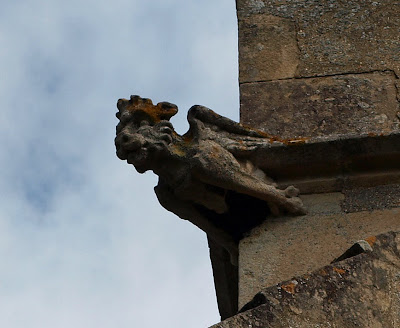Amongst various monuments is a brass in the south aisle of a young woman circa 1530 thought to be Agnes Holden, one of a similar group found only in this area, the peculiarity being in the costumes; beret like headgear, 'mannish' fur collar and knotted girdle, perhaps the product of a Cambridge firm.
ALL SAINTS. W tower of the C15, rebuilt in 1792, altered in 1842. The W parts of nave and aisles also C15. The whole church is over restored. Material: flint-rubble. In the chancel on the N side one original Lancet, proof of a C13 date. Arcades with circular piers, also originally probably of the C13; but re-cut. Indications of former transepts. - BRASS. Woman, early C16, S chapel floor. - Baby in swaddling clothes (John Howard d. 1600, aged 12 days), under arch into S chapel.
GREAT CHESTERFORD. It was an important Roman village before it was an English one, and has sent Roman coins and pottery to Saffron Walden's museum. Every traveller from London to Cambridge knows it, for here the road and railway come together by the River Cam. Its embattled tower is modern, but the church is ancient and has some weird heads on its walls, a winged dragon sprawling over one of the buttresses. The interior is impressive with stately arcades of the 13th century, aisles and a chapel a little younger, and a south chapel of the 16th century. Many quaint carvings in wood and stone are on the corbels in the roofs. We see angels and crowned heads in the chancel, and grotesques in the nave and south chapel; but the best roof of all is the Tudor one in the south aisle, one of its corbels a long haired head with a collar round its neck. There is a 15th century font, a 16th century chest, and two chairs and a communion table from the 17th century. The attractive modern woodwork includes neat screens, choir-stalls carved with kneeling angels, and a lectern formed by an angel with a sword. A lovely Madonna and Child shine from a 700-year-old window in the chancel. Here in brass is Agnes Holden, who founded a chantry not long before chantries were swept away. Her dress with its big cuffs is in the fashion of Henry the Eighth's time. Another little brass figure is full of pathos, showing a son of Lord Howard de Walden in swaddling clothes. He is described as Mr John Howard of 1600, and we read that his time on earth was 12 days.
Sycamores and pines give beauty to the churchyard, which has by its entrance one of Great Chesterford's charming houses. Timbered and plastered, with a gabled storey overhanging, it is thought to have been built in the 15th century, though a 17th century date appears on the plaster. A little way along the lane is another overhanging house of about 1600, and a quarter of a mile off is Manor Farm, built about 1500, with a wing added a generation or two later. On its beams inside are bosses carved with a rose and a pelican.
Flickr set.




No comments:
Post a Comment